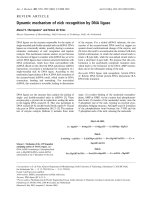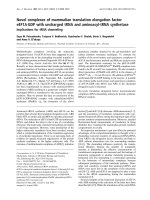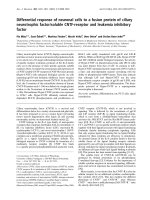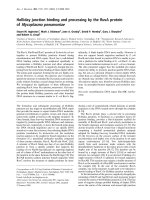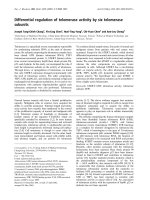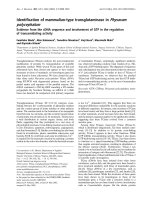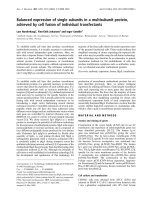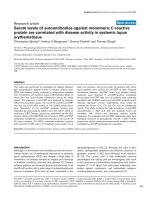Báo cáo Y học: Growth inhibition of mammalian cells by eosinophil cationic protein pptx
Bạn đang xem bản rút gọn của tài liệu. Xem và tải ngay bản đầy đủ của tài liệu tại đây (569.52 KB, 10 trang )
Growth inhibition of mammalian cells by eosinophil cationic protein
Takashi Maeda
1
, Midori Kitazoe
1
, Hiroko Tada
1
, Rafael de Llorens
2
, David S. Salomon
3
,
Masakazu Ueda
4
, Hidenori Yamada
1
and Masaharu Seno
1
1
Department of Bioscience and Biotechnology, Faculty of Engineering, Graduate School of Natural Science and Technology,
Okayama University, Japan;
2
Department of Biology, Faculty of Sciences, University of Girona, Spain;
3
Tumor Growth Factor Section, Basic Research Laboratory, National Cancer Institute, National Institutes of Health,
Bethesda, MD, USA;
4
Department of Surgery, Keio University School of Medicine, Tokyo, Japan
Eosinophil cationic protein (ECP), one of the major
components of basic granules of eosinophils, is c ytotoxic
to tracheal epithelium. However, the extent of this eect
on other cell types has not been evaluated in vitro.Inthis
study, we evaluated the eect of ECP on 13 mammalian
cell lines. ECP inhibited the growth of several cell lines
including those derived from carcinoma and leukemia in a
dose-dependent manner. The IC
50
values on A431 cells,
MDA-MB-453 cells, HL-60 cells and K562 cells were esti-
matedtobe% 1±5 l
M
. ECP signi®cantly suppressed the
size of colonies of A431 cells, and decreased K562 cells in
G
1
/G
0
phase. However, there was little evidence that ECP
killed cells in either cell line. These eects of ECP we re no t
enhanced by extending its N-terminus. Rhodamine B
isothiocyanate-labeled ECP started to bind to A431 cells
after 0.5 h and accumulated for up to 24 h, indicating that
speci®c anity for the cell surface may be important. The
anity of ECP for heparin was assessed and found to be
reduced when tryptophan residues, one of which is located
at a position i n the catalytic subsite o f ribonuclease in
ECP, were modi®ed. The g rowth-inhibitory eect was also
attenuated by this modi®cation. These results suggest that
growth inhibition by ECP is dependent on cell type and is
cytostatic.
Keywords: cell cycle; colony formation; cytostatic eect;
eosinophil cationic protein (ECP); growth inhibition.
Eosinophil cationic protein (ECP) is one of the major
components of eosinophilic granules with a molecular mass
ranging from 16 to 21.4 kDa. It exhibits various biological
effects both in vitro and in vivo [1,2]. It is classi®ed as a
member of the ribonuclease (RNase) A supergene family
because of homology of both nucleotide and amino-acid
sequences. The homology of amino-acid sequences between
human ECP and human RNase 1 is % 30% [3,4]. On the
other hand, ECP s hows signi®cant sequence homology
(70%) with eosinophil-derived neurotoxin (EDN), which is
another human RNase and a component of basic granules
in eosinophils [5]. Recently t he 3D structure of E CP has
been determined and con®rmed the similarity of its s tructure
to other members of the pancreatic-type RNases [6,7]. Some
substitutions of amino-acid residues in the catalytic subsites
are consistent with the weak RNase activity of ECP. ECP is
% 100±2000-fold less active than EDN depending on the
type of substrate [8,9].
ECP is bactericidal [10], helminthotoxic [11±17], elicits the
Gordon phenomenon when injected intrathecally into
rabbits [18,19], and is cytotoxic to tracheal epithelium
[20,21]. Although the mechanism o f its cytotoxicity is not
completely understood, it is suggested to be due to the pore-
forming activity of ECP, which destabilizes lipid membranes
[22] a nd is unrelated to its RNase activity [14,23]. This is
consistent with data showing that the cytotoxicity of ECP is
greater than th at of E DN [13,19,24 ].
In this study, we have assessed the effect of ECP on the
growth of 13 mammalian cell lines. The results s how that
ECP is g rowth inhibitory depending on the cell t ype and is
cytostatic but not cytotoxic. Fluorescent labeled ECP is
shown to enter the c ell whereas RNase A does not. A
speci®c af®nity for the cell surface may b e part of its
cytostatic effect. This ability of ECP to bind to the cell
surface is also shown t o depend on t ryptophan residues.
MATERIALS AND METHODS
Cell cultures
Rat aortic smooth muscle A10 cells, human epidermoid
carcinoma A431 cells, squamous carcinoma TE-8 cells
derived from human esophageal cancer, HC-11 cells cloned
from normal mouse mammary gland epithelia, and
mouse metastatic melanoma-derived B16-BL6 cells were
maintained as described previously [25±27]. Simian virus
(SV)-40-transformed Balb/c 3T3 cell line SV-T2 [28], SV-40
transformed mouse Swiss/3T3 ®broblast cell line 3 T3-SV40
[29], mouse cell line LL/2 established as Lewis lung carcinoma
[30], human colorectal adenocarcinoma cell line HT-29 [31],
human chronic myelogenous leukemia cell line K562 [32],
human acute promyelocytic leukemia cell line HL-60 [33],
and human breast cancer cell line s MDA-MB-453 [34] and
Correspondence to M. Seno, Department of Bioscience and Biotech-
nology, Faculty of Engineering, Graduate school of Natural Science
and Technology, Okayama University, 3.1.1 Tsushima-Naka,
Okayama 700-8530, Japan. Fax/Tel.: + 81 86 251 8216,
E-mail:
Abbreviations: ECP, eosinophil cationic protein; EDN, eosinophil-
derived neurotoxin; RNase, ribonuclease; SV, simian virus; MTT,
3-(4,5-dimethylthiazol-2-yl)-diphenyltetrazolium bromide; RITC,
rhodamine B isothiocyanate; NBS, N-bromosuccinimide.
(Received 31 August 2001, revised 26 October 2001, accepted 5
November 2001)
Eur. J. Biochem. 269, 307±316 (2002) Ó FEBS 2002
T-47D [35] were obtained f rom American Type Culture
Collection (USA) or Dainippon-Pharmaceutical Co. ( Japan)
and maintained as directed.
Preparation of recombinant human ECP
HumanECPcDNAwasisolatedandexpressedinan
Escherichia coli T7 expression system as described previ-
ously [7]. Computer analyses fo r the sec retion signal [36,37]
predicted the cleavage site of ECP to be between Gly23 and
Ser24. On the other hand, ECP puri®ed fro m normal
human eosinophils had Arg28 at its N-terminus [38]. Hence
two different types of ECP were prepared. To distinguish
between them, the one with an N-terminal extension from
Ser24 was designated (À4) ECP. Puri®ed ECP and
(À4) ECP w ere assessed for RNase activity on yeast RNA
by the perchloric acid precipitation method as previously
described [39] and for bactericidal activity against Staphy-
lococcus aureus 209P FDA by counting the colonies on
plates [23]. The N-terminal sequences, CD spectra, and
apparent molecular masses in SDS/PAGE of both proteins
were con®rmed to be as designed except for the ®rst
methionine residue of (À4)ECP,whichwasprocessedoff.
MTT assay for cell growth
The effect of ECP on the growth of various cell lines was
assessed by colorimetric assay using 3-(4,5-dimethylthiazol-
2-yl)-diphenyl-tetrazolium b romide (MTT) [25]. Cells were
plated into 96-well plates (Nalge-Nunc, USA) in appropri-
ate media containing 10% fetal bovine serum at 500 cells per
well. After 24 h, each sample was added a t the indicated
concentration (0±10 l
M
). Four days after plating, the
medium was replaced with fresh medium containing each
sample at the same concentration. After a further 4 days of
cultivation, MTT (5 mgÁmL
À1
in NaCl/P
i
) was added, and
cell growth was monitored by measuring A
570
.
Counting of viable cells
The number of K562 cells under v arious conditions was
counted. First, 25 000 cells were seeded into a 35-mm dish
(Falcon), and appropriate concentrations of ECP (À4) or
ECP and RNase A were simultaneously add ed. After
1±3 days of cultivation, viable cells unstained with Trypan
blue were counted with a hemocytometer.
Observation of cell morphology
K562 and A 431 cells were seeded into 24-well plates or
35-mm dishes, and, after 24 h, ECP was added at a concen-
tration of 10 l
M
. At appropriate times during the culture,
the morphology of the cells was observed with a phase-
contrast inverted microscope (CK -2; Olympus, Tokyo,
Japan) equipped with a charge-coupled device video camera.
Cell cycle analysis
K562 cells were seeded at 500 000 cells per 6 0-mm dish in
the growth medium. After 2 4 h, the medium was changed to
fresh medium with 10 l
M
ECP or bovine RNase A (Sigma).
After 3 days of treatment, cells were harvested, washed with
NaCl/P
i
, treated with NaCl/P
i
containing 0.25% Triton
X-100 and 0.15 mgÁmL
À1
RNase A for 15 m in at room
temperature. The cells were then ®xed in 70% ethanol
overnight at 4 °C and this was followed by further
treatment with RNase A (0.1 mgÁmL
À1
)inNaCl/P
i
for
10 min at 37 °C. The DNA o f the ®xed cells was stained
with propidium iodide (50 mgÁmL
À1
) for 30 min at room
temperature, and the cells were analyzed by FACSCalibur
(Becton Dickinson).
Assay of colony formation
A431 cells suspended in the medium were seeded into
35-mm dishes at 10 000 cells per dish. After 24 h, ECP was
added at 10 l
M
to the medium and the cells were cultured
for an additional 3 days. The medium containing ECP was
then changed. Seven days afte r seeding, the cells were ®xed
with 10% formaldehyde a nd stained with C rystal violet.
The number of colonies was counted, a nd the area occup ied
by the colonies was evaluated by image scanning assisted by
a computer.
Fluorescence microscopy
ECP and bovine RNase A were labeled with rhodamine B
isothiocyanate (RITC; Sigma) as previously described [40].
Cells were seeded into an eight-well Laboratory-Tek
Chamber Slide (Nunc) at 20 000 cells per well and cultured.
After 24 h, cells in each well were treated with RITC-labe led
protein at a concentration of 1 l
M
for 0.5±24 h, then
washed with NaCl/P
i
, and observed under a ¯uorescent
microscope (BX40; Olympus). Hoechst 33342 dissolved in
NaCl/P
i
to 2 l
M
(Molecular Probes) was used for nuclear
staining.
Oxidation of tryptophan residues
Two tryptophan residues were modi®ed by oxidation with
N-bromosuccinimide (NBS; Sigma) as p reviously described
[41]. Brie¯y, 1.37 mg ÁmL
À1
NBS dissolved in 50 m
M
sodium acetate, pH 4.5, was gradually added to a solution
of ECP (1.6 mgÁmL
À1
) in the same buffer. Oxidation was
monitored by measuring the decrease in A
280
during t he
course of the reaction. After dialysis against Milli-Q water,
the solution of modi®ed ECP was assessed for amino-acid
composition and presence of tryptophan residues.
Heparin-af®nity column chromatography
ECP with or without modi®cation was applied to a heparin
af®nity column (Heparin-Cellulo®ne; 4 ´ 150 mm; Chisso,
Japan) equilibrated with 50 m
M
phosphate buffer, pH 7.0,
and eluted with a linear gradient of NaCl (0.2±0.7
M
per
60 min) at a ¯ow rate of 0.6 mLÁmin
À1
.TheA
273
derived
from tyrosine residues w as monitored and the af®nity of
each protein for heparin was evaluated as the retention time
of the peak t op of each pro®le.
RESULTS
ECPs with two different N-termini
As there is a discrepancy in the N-terminus between the
predicted and the puri®ed ECP protein, post-translational
308 T. Maeda et al.(Eur. J. Biochem. 269) Ó FEBS 2002
processing might be involved in the truncation of t he
N-terminal sequence of ECP. We thought that it was
important to assess the effect of this N-terminal extension in
ECP because EDN has a similar four amino-acid extended
form that conferred cytotoxic activity on KS Y-1 cells,
which are neoplastic endothelial cells derived f rom Kaposi's
sarcoma [42]. We therefore expressed two types of recom-
binant human E CP using the T7 expression system
(Fig. 1A). RNase activity of ECP and (À4) ECP against
yeast RNA was 100 times lower than that of bovine
RNase A (Fig. 1B), which is consistent with a previous
report on the activity of ECP puri®ed from eosinophils [43].
ECP and (À4) ECP showed no difference in RNase activity
(Fig. 1 B). Both forms of ECP exhibited bactericidal activity
against S. aureus whereas RNase A did not show any
activity (Fig. 1C). Therefore, both forms of recombinant
ECPs were biologically active.
Effect of ECPs on various cell lines
The growth-modulatory e ffects of ECP and (À4) ECP were
assessed on 1 3 cell lines derived from humans and rodents.
The results are summarized in Table 1. ECP showed the
strongest inhibition of growth in leukemia-derived cells
K562 and HL-60 with an IC
50
(concentration that causes
50% inhibition) of 1.1 l
M
. A431, M DA-MB-453 and
HC-11 cells were also sensitive to ECP with IC
50
values of
% 4±6 l
M
.The(À4) ECP protein also inhibited the growth
Fig. 1. N-Terminal sequences of ECP, its
ribonucleolytic activity and bactericidal activity.
(A) The signal cleavage site is predicted to lie
between Gly23 and Ser24 whereas the
N-terminus is reported to be Arg28 w hen
puri®ed from eosinophils. R ecombinant E CP
was prepared as the mature form starting from
Arg28 as indicated by the arrow at the top,
and (À4) ECP was prepared with an extension
of four amino-acid residues (in bold letters) as
also indicated by the arrow at the bottom.
RNase activity against yeast RNA (B) and
bactericidal activity against S. aureus (C) of
each ECP (d)and(À4) ECP (j)wereeval-
uated. Bovine RNase A ( s)isacontrol.
Table 1. E ect of ECP and (À4) ECP on cell growth. All assays were carried out in quadruplicate in a 96-well plate and SD was calculated. SC,
Percentage of cells that survived at 10 l
M
ECP or (À4) ECP; NT , not test ed; NA, no t applicable .
Cell line Origin
ECP (À4) ECP
IC
50
(l
M
)
SC
(%)
IC
50
(l
M
)
SC
(%)
Human
K562 Chronic myelogenous leukemia 1.1 1.7 0.3 2.0 3.0 1.3
HL-60 Acute promyelocytic leukemia 1.1 2.1 0.5 2.0 5.4 2.4
A431 Epidermoid carcinoma 4.0 38.7 7.6 6.0 49.3 9.7
MDA-MB-453 Breast carcinoma (mammary gland) 4.0 31.3 4.7 NT NT
TE-8 Squamous carcinoma NA 68.5 2.8 NT NT
T-47D Ductal carcinoma (mammary gland) NA 90.3 3.9 NT NT
HT-29 Colon adenocarcinoma NA 75.3 4.7 NA 80.5 2.8
Mouse
B16-BL6 Metastatic melanoma NA 73.5 + 9.0 NT NT
LL/2 Lewis lung carcinoma NA 93.5 5.5 NA 100.6 4.5
3T3-SV40 SV-40-transformed Swiss 3T3 cells NA 57.6 9.8 NA 58.9 8.5
SV-T2 SV-40-transformed Balb/c 3T3 cells NA 90.3 8.7 NA 95.2 8.2
HC-11 Normal mammary gland epithelial cells 6.0 42.8 5.2 6.0 38.3 + 4.4
Rat
A10 Normal aortic smooth muscle cells NA 84.5 + 2.3 NT NT
Ó FEBS 2002 Cytostatic eect of ECP (Eur. J. Biochem. 269) 309
of these cell lines. However (À4) ECP was less active than
ECP. T-47D, LL/2 and SV-T2 cells were resistant to ECP
while TE-8, HT-29, B16-BL6, 3T3-SV40 and A10 cells were
marginally sensitive such that t he IC
50
values could not be
accurately calculated but were more than 10 l
M
.
Effect of ECP on A431 and K562 cells
At 5 l
M
ECP, the grow th of K 562 cells was completely
suppressed whereas growth inhibition of A431 cells was
% 50% (Fig. 2). As ECP is a member of the supergene family
of pancreatic-type RNases and is unique in this family for
its basic pI, its growth-inhibitory effect was compared w ith
that of both bovine R Nase A and poly(
L
-lysine) (a verage
molecular mass 2900). Neither RNase A nor poly
(
L
-lysine) had any effect on the growth of thes e cel ls (Fig. 2).
After 7 days of incubation, ECP and (À4) ECP appeared to
inhibit the aggregation of K562 cells and to keep them sparse
(Fig 2C,D) in contrast with control cells or cells treated with
RNase A, which grew as aggregates (Fig. 2 A,B). It is
interesting to note that even (À4) ECP, which a llowed cell
growth because of its weaker effect (Fig. 3A), appeared to
suppress cell aggregation. A431 cells are epithelial-like cells
and have a typical cobblestone appearance (Fig. 2E). They
show this cobblestone pattern even when seeded at lower
density, as shown in Fig. 4A for instance. Although this
morphology was not affected by RNase A (Fig. 2F), the
cells treated with ECP for 5 days were more stellate in
appearance (Fig. 2G). These cells resumed growth when
ECP w as removed from the culture medium (Fig. 2H).
As the growth inhibition of K562 cells in Fig. 2 was
shown after 7 days of treatment with ECP, which was
Fig. 2. Suppression of cell growth in the presence of ECP. Left, the percentages of viable cells under various concentrations of RNase A (s), po ly
(
L
-lysine) (n), (À4) ECP (j)andECP(d) were plotted. Growth of K562 and A431 cells was monitored by MTT assay. Each assay was carried out
in quadruplicate and standard deviation was calculated and depicted in each vertical line. Right, K562 cells seeded at 500 cells per 35-mm dish were
cultured for 7 days in the regular medium (A) and in the presence of 10 l
M
each RNase A (B), ECP (C) and (À4) ECP (D). A431 cells seeded at 500
cells per 35-mm dish and cultured for 5 days in the regular medium (E) and in the presence of 10 l
M
each RNase A (F) and ECP (G). Four days
after p lating, the medium was replaced with fresh medium containing each sample at the same concentration. ECP-treated A 431 cells (G) were
further cultured f or 3 days in the regular medium without ECP (H). (G) and (H) sh ow the same ®eld of t he same dish . Original magni®cations of the
plates are ´ 10.
310 T. Maeda et al.(Eur. J. Biochem. 269) Ó FEBS 2002
supplemented by the medium change, this effect was
assessed in the ®rst 3 days of treatment by monito ring the
cell number (Fig. 3A). (À4) ECP was less active as a growth
inhibitor during this p eriod and the effect of ECP lasted
almost throughout not allowing any appreciable increase in
cell number. K562 cells treated with ECP were further
analyzed by ¯ow cytometry; a signi®cant decrease was
observed in the population of cells in the G
1
/G
0
phase of the
cell cycle, and a small increase in the dying population when
compared with K562 cells culture d in regular medium or
cells treated with RNase A (Fig. 3B). However, the popu-
lation in the G
2
/M phase of the cell cycle was not altered,
and the total cell number was unaffected. A small number of
K562 cells in the G
1
/G
0
phase of the cell c ycle that had been
treated with E CP or (À4)ECPappearedtobedead.
The effect of ECP in the early period without medium
change was monitored on A431 cells (Fig. 4). Up to 4 days
after the addition of ECP, A431 cells were more sparse and
were more ®broblastic in appearance (Figs 4D,E) in con-
trast with control A431 cells (Fig. 4A,B) or A431 cells
treated with RNase A (Fig 4G,H). In the presence of ECP,
the cells were more ¯at and spread out after 6 d ays of
treatment (Fig. 4F). Nuclei were more pronounced because
of the low density and ¯attened shape of the cells (Figs 4A±
C). Very recently, we found that ECP-treated Balb/c 3T3
cells exhibited a similar change in morphology with
enhanced expression of vinculin (M. Kitazoe, T. Maeda,
H. Tad a, R. de Llorens, D . S . S alomon, M. Ueda,
H. Yamada & M. Seno, unpublished results). The e ffect
of ECP o n the cell shape might be due to the regulation of
vinculin gene exp ression as previously described [44,45].
The numbers of A431 colonies in the dishes (2500 110
colonies per 35-mm dish) that received ECP or RNase A
were almost equivalent to the number of colonies in control
A431 cells (Fig. 5A). However, ECP produced a signi®cant
decrease in the size of the colonies of 60% compared with
control cells (Fig. 5B). These results d emonstrate t hat E CP
impairs the growth of cells.
Cellular localization of ECP
To assess whether E CP could b e localized, A431 cells were
incubated with RITC-labeled ECP at 37 °C for various
times (Fig. 6). From 0.5 to 3 h, A431 cells exhibited
increased levels of ¯uorescence labeling in the cytoplasm
rather than the nuclei. After 24 h, the ¯uorescence increased
in the cells. There was no uptake of RITC-labeled RNase A
into the cells, indicating that ECP may interact prefe ren-
tially with a receptor or binding protein on t he cell surface.
We attempted to observe the speci®c binding using ECP and
RITC-labeled ECP by monitoring the level of ¯uo rescence,
but the change in ¯uorescence level caused by the compe-
tition of ECP and RITC-labeled ECP could not be detected.
This is probably because at least 1 l
M
RITC-labeled ECP
was r equired t o detect the ¯uorescence, and this concentra-
tion may be too high to compete with the ECP, the practical
maximum c oncentration of w hich is 10 l
M
. Although we
could not show speci®c binding of ECP to c ells using a
competition a ssay, we could assess the af®nity of ECP for
heparin using heparin af®nity co lumn chromatography
(Fig. 7 A). ECP was eluted at about 0.64
M
NaCl, and
(À4) ECP a nd NBS-modi®ed ECP were eluted at 0.60 and
0.56
M
NaCl, respectively. The amino-acid composition of
NBS-modi®ed ECP con®rmed that only tryptophan resi-
dues had been modi®ed. As shown in F ig. 7B, these
tryptophan residues a re located in the RNA c atalytic site
of ECP and may contribute to the binding to heparin. The
cleft of the catalytic site possibly functions as the site of
attachment to proteoglycans on the cell s urface. As NBS-
modi®ed ECP inhibited the growth of A431 cells less than
(À4) ECP and the IC
50
could not be determined (T. Maeda,
D. L. Newton, S. M. Rybak, unpublished results), the
af®nity for heparin must also be responsible for the growth-
inhibitory effect.
DISCUSSION
This is the ®rst report to demonstrate that ECP has a
growth-inhibitory effect that is cytostatic and dependent on
cell type. The growth of four of the seven human cell lines
Fig. 3. Growth-inhibitory eect of ECP on K562 cells. (A) Cells were
seeded at 25 000 cells per 35-mm dish. Simultaneously, 10 l
M
each
RNase A, ECP and (À4) ECP were added t o the medium. After the
indicated number of days of culture, the viable cells in the dishes were
counted. The cell numbers are the average from three ind ependent
experiments and standard deviations are depic ted by vertical lines on
the top of each bar. The ho rizontal gray line shows the c ell n umber
seeded at the beginning of the experiments. (B) Cells were seeded at
500 000 cells per 60-mm dish, cultured for 3 days in the presence or
absence of 10 l
M
ECP or RNase A and analyzed by a ¯ow cytometer.
The area of dead cells is shaded. Peaks I and II show the population of
cells in G
1
/G
0
and G
2
/M phase, respectively.
Ó FEBS 2002 Cytostatic eect of ECP (Eur. J. Biochem. 269) 311
Fig. 4. Time course change in the morphology of A431 cells treated with ECP. A431 cells were seeded into a 24-well plate at 5000 cells per well. After
24 h, medium was changed to a fresh one (A, B, C) or one containing 10 l
M
ECP (D, E, F) or RNase A. (G, H, I). Cells were photographed 1 day
(A, D, G), 4 days (B, E, H) and 6 days (C, F, I) after the change of medium. Original magni®cations are ´ 10.
Fig. 5. Growth-inhibitory eect of ECP on
A431 cells. A431 cells were seeded at 5000 cells
per 35-mm dish, and 2500 110 colonie s
were formed in the presence or absence of
10 l
M
RNase A or ECP (A). The percentage
of areas of colonies treated with RNase A and
ECP were calculated taking colonies cultured
in the grow th m edi um as 1 00% (B). This
experiment was rep eated t hree times. Ph oto-
graphs are the typical pattern of the colonies,
and the percen tages are the mea ns of each
result with the standard deviations within
10%.
312 T. Maeda et al.(Eur. J. Biochem. 269) Ó FEBS 2002
was inhibited, whereas the rodent cell lines were relatively
resistant. The resistance of the rodent cell lines to the
growth-inhibitory effects of human ECP may be due to the
evolutionary divergence of ECP, which resulted in signi®-
cantly low homology of e osinophil-derived RNase between
species [46,47]. In this study, ECP suppressed the growth of
K562, HL-60, A431 and MDA-MB-453 cell lines in an
IC
50
range o f 1±4 l
M
. A lthough the primary structure of
human ECP shows the closest identity (67%) with human
EDN, the N-terminal extension of which confers cytotox-
icity against KS Y-1 cells [42], the N-terminal extension
of ECP did not produce any enhancement of the growth-
inhibitory effects on this cell line (personal communi-
cation, D. L. Newton and S. M. Rybak, National Cancer
Institute, National Institutes of Health, Frederick, MD,
USA). On the contrary, the N-terminal extension of E CP
appears to impair the inhibito ry effect of ECP on some cell
lines.
Fig. 6. A431 cells treated with RITC-labeled ECP. A431 cells were seeded into the eight-well Laboratory-Tek chamber slide at 20 000 cells per well.
After 24 h, 1 l
M
each RITC-labeled ECP and RNase A was added to the c ulture medium , and the cells we re ®xed and detected by ¯uorescent
microscopy at the time indicated. RITC-labeled ECP or RNase A was visualized (top) and nuclei of the cells stained with Hoechst 33342 (bottom).
The same ®eld was assigned in the same column at each time. The scale bar i s equivalent to 50 lm.
Fig. 7. Heparin anity column chromatography of ECP (A) and schematic diagram of ECP depicted with RasMol v2.6 according to the PDB entry
1DVT (B). (A)ECPmodi®edwithNBS(a)(À4) ECP (b) or ECP (c) was applied to a heparin column and eluted with a linear gradient of NaCl. The
retentiontimeofeachpeakofpro®lesis43min(0.64
M
NaCl) for NBS-modi®ed ECP, 48 min (0.60
M
NaCl) for (À4) ECP and 53 min (0.56
M
NaCl) for ECP. RNase A passed through this anity column under the same conditions. (B) The backbone of peptide bonds is drawn in gray. The
secondary-structure elements are helices and arrows for a he lic es and b strands, respectively. Two tryptophan residues, W10 and W35, and the other
amino-acid residues in the catalytic subsites are in black with their side chains. H64 is located in the P0 subsite, H15, K38 and H128 in the P1 subsite,
and W10 in the P2 subsite.
Ó FEBS 2002 Cytostatic eect of ECP (Eur. J. Biochem. 269) 313
ECP is unique among RNase A enzymes because of its
high arginine content. Therefore, the nonspeci®c effect of
growth inhibition may be replicated by other polycations.
To investigate this, we checked the effect of poly(
L
-lysine),
which has a cationic charge that is almost equivalent to that
of ECP. It did not have any growth-inhibitory effect on
K562 and A431 cells (Fig. 2). Although we could not obtain
polyarginine, we assessed the effect of the third helix of the
Drosophila antennapedia homeodomain [48] and the basic
region of HIV-Tat p rotein [49], both of w hich are rich in
basic amino acids and known to enhance cellular uptake.
Neither of these peptides showed any growth-inhibitory
effect similar to ECP (data not shown). Therefore, the
cationic charge could not replicate the effect of ECP.
Recently, it has been shown that the amphipathic helix
structure o f the basic region of Tat protein may be
important for the uptake of the protein into cells [50]. This
mechanism may not apply to ECP as ECP is an arginine-
rich protein but does not have the cluster of arginine
residues like Tat protein. On the other hand, highly
cationized RNase molecules are cytotoxic but are not
cytostatic like ECP [51].
The cytostatic growth-inhibitory effect of ECP was not
suf®cient to induce cell death, as the initial number o f viable
K562 cells did not signi®cantly decrease in the presence of
ECP. Cell cycle a nalysis showed that ECP decreased K562
cells in the G
1
/G
0
phase without having an effect on the G
2
/
M phase. The number of dying cells increased slightly but
this was not signi®cant. The growth-in hibitory effect of ECP
was reversible as A431 cells treated with ECP resumed
normal g rowth w hen ECP was removed from the medium.
In addition, ECP affected the size of colonies of A431 cells
but not colony number. Furthermore, we found no effect of
ECP on the frequency of apoptosis as assessed by DNA
ladder formation and phosphatidylserine externalization
(data not shown).
RITC-labeled ECP appeared to accumulate in the cyto-
plasm after 24 h. However, whether endocytosis of ECP
ocurred is still unclear. It may be in vesicles or endosomes. As
the cellular outlines were not enhanced during the course of
the incubation, we conclud ed that speci®c accumulation of
ECP o n t he cell surface was not occurring. The most probable
explanation for this observation is the presence o f cell s ur-
face receptors for ECP. We could no t show the presence of a
speci®c high-af®nity binding site for ECP on cells by com-
petition assay. This is probably because the af®nity of ECP
for binding to extracellular matrix proteins such as heparan
sulfate is extremely low and rapidly dissociates. However, it
is very interesting to note that ECP can bind to heparin and
that tryptophan residues contribute to this af®nity. As tryp-
tophan residues are also responsible for the af®nity for
galactose and lactose residues of some lectins [52], it i s feasible
that this is also the case for ECP. The trypto phan residues
are Trp10 and/or Trp35 in ECP. Interestingly, Trp10 is
located at the P2 subsite of the catalytic domain of RNase
and controls the weak RNase activity of the p rotein [6].
Trp35 is a unique amino-acid residue at a position in
Loop-3 of the RNases. As both tryptophan residues are
located on t he same side of the molecule, it is dif®cult to
ascertain which residue is more critical for the the binding of
ECP to heparin or other carbohydrates.
In conclusion, ECP has a cell-type-speci®c cytostatic
growth-inhibitory effect. It is possible that this activity is due
to the presence of the tryptophan residues. We are now
producing mutant ECP proteins to assess this aspect.
Further evaluation of the ECP molecule including the
generation of a mutant protein will enable us to test the
effects of ECP on in¯ammatory diseases, in w hich uncon-
trolled cell growth c ould contribute t o a delay in wound
healing. In addition, strong local in¯ammatory responses
that are speci®c to cytokines such as interleukin-4, are
capable in some cases of mediating regression of tumors
[53,54]. In¯ammatory in®ltrates comprised of eosinophils
may also play an important role at the primary site of tumor
regression by releasing ECP as part of the cascade of
inducing a tumor-speci®c T-cell response. Optimization of
the biological activity of the ECP p rotein to target the cell
surface could bring IC
50
values down t o practical levels so
that it might be used as an anti-cancer reagent in the same
way as others [27,55±57].
ACKNOWLEDGEMENTS
We thank Drs S. Rybak and D. Newton for assaying the eects of ECP
and (À4) ECP on KS Y-1 cells, Professor K. O guma for providing
S. aureus cells, Professor M. Hikida for help with ¯ow-cytometric
analysis, and Drs R. Sasada, S. Ishikami and J. Futami for helpful
discussions and suggestio ns throughout this work. T his work was partly
supported b y a grant-in-aid f rom the Ministry of Education, Science ,
Culture and Sports of Japan. R. de Ll. was supported by the Spanish
Ministerio de Educacio
Â
n y Cultura (grant SAF 9 8-0086 and 2FD 97-
0872) and by Generalitat de Catalunya (grant SGR97-240).
REFERENCES
1. Rosenberg, H.F. (1998) The eosinophil ribonucleases. Cell. Mol.
Life Sci. 54, 795±803.
2. Giembycz, M.A. & Lindsay, M.A. (1999) Pharmacology of the
eosinophil. Pharmacol. Rev. 51, 213±340.
3. Seno, M., Futami, J., Kosaka, M., Seno, S. & Yamada, H. (1994)
Nucleotide sequence encoding human pancreatic ribonucle ase.
Biochim. Biophys. Acta 1218, 4 66±468.
4.Futami,J.,Tsushima,Y.,Murato,Y.,Tada,H.,Sasaki,J.,
Seno, M. & Yamada, H. (1997) Tissue-speci®c expression of
pancreatic-type RNases and RNase inhibitor in humans. DNA
Cell Biol. 16, 413±419.
5. Gleich, G.J., Loegering, D.A., Bell, M.P., Checkel, J.L., Acker-
man, S.J. & McKean, D.J. (1 986 ) Biochemical and function al
similarities between human eosinophil-derived neurotoxin and
eosinophil cationic protein: homology with ribonuclease. Proc.
Natl Acad. Sci. USA 83, 3146±3150.
6. Boix, E., Leonidas, D.D., Nikolovski, Z., Nogues, M.V., Cuchillo,
C.M. & Acharya, K .R. ( 1999) Crystal structure of eosinophil
cationic protein at 2.4 A
Ê
resolut io n. Biochemistry 38, 16794±16801.
7. Mallorqui-Fernandez, G., Pous, J., Peracaula, R., Aymami, J.,
Maeda,T.,Tada,H.,Yamada,H.,Seno,M.,deLlorens,R.,
Gomis-Ruth, F.X. & Coll, M. (2000) Three-dimensional crystal
structure of human eosinophil cationic protein (RNase 3) at 1.75
A
Ê
resolution. J. Mol. Biol. 300, 1297±1307.
8. Slifman, N.R., Loegering, D.A., McKean, D.J. & Gleich, G.J.
(1986) Ribonuclease activity associated with human eosinophil-
derived neurotoxin and eosinophil cationic protein. J. Immunol.
137, 2913±2917.
9. Rosenberg, H.F. & Dyer, K.D. (1997) Diversity among the pri-
mate eosinoph il-derived neurotoxin genes: a speci®c C-terminal
sequence is necessary for enhanced ribonuclease activity. Nucleic
Acids Res. 25, 3532±3536.
10. Lehrer, R.I., Szklarek, D., Barton, A., Ganz, T., Hamann, K.J. &
Gleich, G.J. (1989) Antibacterial properties of eosinophil major
314 T. Maeda et al.(Eur. J. Biochem. 269) Ó FEBS 2002
basic protein and eosinophil cationic p rotein. J. Immunol. 142,
4428±4434.
11. Ackerman, S.J., Gleich, G.J., Loegering, D.A., Richardson, B.A.
& Butterworth, A.E. (1985) Comparative toxicity of puri®ed
human eosinophil granule cationic proteins for sc histosomula
of Schistosoma mansoni. Am. J. Trop. Med. Hyg. 34, 735±745.
12. Hamann, K.J., Gleich, G.J., Checkel, J.L., Loegering, D.A.,
McCall, J.W. & Barker, R.L. (1990) In vitro killing of micro®lariae
of Brugia pahangi and Brugia malayi by e osinophil g ranule pro -
teins. J. Immunol. 144, 3166±3173.
13. Hamann, K.J., Barker, R .L., Loegering, D.A. & Gleich, G.J.
(1987) Comparative toxicity of puri®ed human eosinophil granule
proteins for ne wborn larvae of Trichinella spiralis. J. Parasitol. 73,
523±529.
14. Molina, H.A., Kierszenbaum, F., Hamann, K.J. & Gleich, G.J.
(1988) Toxic eects produced or m ediated by human eosinophil
granule com ponents on Trypanosoma cruzi. Am. J. Trop. Med.
Hyg. 38, 327±334.
15. McLaren, D.J., McKean, J.R., Olsson, I., Venges, P. & Kay, A.B.
(1981) Morphological studies on the killing of schistosomula of
Schistosoma mansoni by human eosinophil and neutrophil cationic
proteins in vitr o. Parasite Immunol. 3, 359±373.
16. Yazdanbakhsh, M., Tai, P.C., Spry, C.J., Gleich, G.J. & Roos, D.
(1987) Synergism between eosinophil cationic protein and oxygen
metabolites in killing of schistosomula of Schistosoma mansoni.
J. Immunol. 138, 3443±3447.
17. Waters, L.S., Taverne, J., Tai, P.C., Spry, C.J., Targett, G.A. &
Playfair, J.H. (1987) Killing of Plasmodium falciparum by eosin -
ophil secretory products. Infect. Immun. 55, 877±881.
18. Durack,D.T.,Sumi,S.M.&Klebano,S.J.(1979)Neurotoxicity
of human eosinophils. Proc. Natl Acad. Sci. USA 76, 1443±1447.
19. Fredens, K., Dahl, R. & Venge, P. (1982) The Gordon phenom-
enon induced by the eosinophil cationic protein and eosinophil
protein X. J. Allergy Clin. Immunol. 70, 361±366.
20. Motojima, S., Frigas, E., Loegering, D.A. & Gleich, G.J. (1989)
Toxicity of eosinophil cationic pro teins for guinea p ig tracheal
epithelium in vitro. Am. Rev. Respir. Dis. 139, 801±805.
21. Fredens, K., Dybdahl, H., Dahl, R. & Baandrup, U. (1988)
Extracellular deposit of the c ationic proteins ECP and EPX in
tissue in®ltrations of eosinophils related to tissue damage. APMIS
96, 711±719.
22. Young, J.D., Peterson, C.G., Venge, P. & Cohn, Z.A. (1986)
Mechanism of membrane damage mediated by human eosinophil
cationic protein. Nature (London) 321, 613±616.
23. Rosenberg, H.F. (1995) Recombinant human eosinophil cationic
protein. Ribonuclease activity is n ot essential fo r cytotoxicity.
J. Biol. Chem. 270, 7876±7881.
24. Barker, R.L., Ten Loegering, D.A.R.M., Hamann, K.J., Pease,
L.R. & Gleich, G.J. (1989) Eosinophil cationic protein cDNA.
Comparison with other toxic cationic proteins and ribonucleases.
J. Immunol. 143, 952±955.
25. Seno, M., Tada, H., Kosaka, M., Sasada, R., Igarashi, K., Shing,
Y.,Folkman,J.,Ueda,M.&Yamada,H.(1996)Humanbeta-
cellulin, a member o f the EGF fa mily dominantly expressed in
pancreas and small intestine, is fully active in a monomeric form.
Growth Factors 13, 181±191.
26. Seno,M.,DeSantis,M.,Kannan,S.,Bianco,C.,Tada,H.,Kim,
N., Kosaka, M., Gullick, W.J., Yamada, H. & Salomon, D.S.
(1998) Puri®cation and characterization of a recombinant human
cripto-1 protein. Growth Factors 15, 215±229.
27. Futami,J.,Seno,M.,Ueda,M.,Tada,H.&Yamada,H.(1999)
Inhibition of cell growth by a fused protein of human ribonuclease
1 and human b asic ®broblast growth factor. Protein E ng. 12,
1013±1019.
28. Aaronson, S.A. & Todaro, G.J. ( 1968) Development of 3 T3-like
lines from Balb-c mouse em bryo cultures: transformation sus-
ceptibility to SV40. J. Cell. Physiol. 72, 141±148.
29. O'Neill, F.J. (1975) Control of nuclear division in sv40 and ade-
novirus type 12 transformed mouse 3t3 cells. Int. J. Cancer 15,
715±723.
30. Bertram, J.S. & Janik, P. (1980) Establishment of a cloned line of
Lewis Lung Carc inoma cells adapted to cell cultu re. Cancer Lett.
11, 63±73.
31. von Kleist, S., Chany, E., Burtin, P., King, M. & Fogh, J. (1975)
Immunohistology of the antigenic pattern of a continuous
cell line from a human colon tumor. J. Natl Cancer Inst. 55,
555±560.
32. Andersson, L.C., Nilsson, K. & Gahmberg, C.G. (1979) K562: a
human erythroleukemic cell line. Int. J. Cancer 23, 143±147.
33. Collins, S.J., Gallo, R.C. & Gallagher, R.E. (1977) Continuous
growth and dierentiation of human myeloid leukaemic cells in
suspension culture. Nature (London) 270, 347±349.
34. Cailleau, R., Olive, M. & Cruciger, Q.V. (1978) Long-term human
breast carcinoma cell lines of metastatic origin: p reliminary char-
acterization. In Vitro 14, 911±915.
35. Prager, A., Ben-Hur, E., Ch aitcik, S., Brenn er, H.J. & Riklis, E.
(1981) Characterization of the response of a human breast carci-
noma cell line (T-47D) to radiation and chemotherapeutic agents.
Isr. J. Med. Sci. 17, 976±979.
36. Nakai, K. & Kanehisa, M. (1992) A k nowledge base for predict-
ing protein localization sites in eukaryotic cells. Genomics 14,
897±911.
37. Nielsen, H., Engelbrecht, J., Brunak, S. & von Heijne, G. (1997)
Identi®cation of prokaryotic and e ukaryotic signal peptide s and
prediction of their cleavage sites. Protein Eng. 10, 1±6.
38. Peterson, C.G., Jornvall, H. & Venge, P. (1988) Puri®cation and
characterization of eosinophil cationic protein from normal
human eosinophils. Eur J. Haematol. 40, 415±423.
39. Futami, J., Seno, M., Kosaka, M., Tada, H., Se no, S. &
Yamada, H. (1995) Recombinant human pancreatic ribonuclease
produced in E. coli: importance of the amino-terminal sequence.
Biochem. Biophys. Res. Commun. 216, 406±413.
40. Hiratsuka, T. (1987) Selective ¯uorescent labeling of the 50-, 26-,
and 20-kilodalton heavy chain segments of myosin ATPase.
J. Biochem. (Tokyo) 101, 1457±1462.
41. Spande, T.F., Green, N.M. & Witkop, B. (1966) The reactivity
toward N-bromosuccinimide of tryptophan in enzymes, zymogens,
and inhibited enzymes. Biochemistry 5, 1926±1933.
42. Newton, D.L. & Rybak, S.M. (1998) Unique recombinant human
ribonuclease and inhibition of Kaposi's sarcoma cell growt h.
J. Natl Cancer Inst. 90, 1787±1791.
43. Sorrentino, S. & Libonati, M. (1997) Structure±function rela-
tionships in human ribonucleases: main distinctive features of the
major RNase types. FEB S Lett. 404, 1±5.
44. Rodriguez F ernandez, J.L., Geiger, B., Salomon, D., Sabanay, I.,
Zoller, M. & Ben-Ze'ev, A. (1992) Suppression of tumorigenicity
in transformed cells after transfection with vinculin cDNA. J. Cell
Biol. 119, 427±438.
45. Rodriguez Fernandez, J.L., Geiger, B., Salomon, D. & Ben-Ze'ev,
A. (1993) Suppression of vinculin expression by antisense trans-
fection confers changes in cell m orphology, motility, and ancho-
rage-dependent growth of 3T3 cells. J. Cell Biol. 122, 1285±1294.
46. Larson, K .A., Olson, E.V., Madden, B.J., Gleich, G.J., Lee, N.A.
& L ee, J.J. (1996) Two highly homologous ribonuclease ge nes
expressed i n mouse eosinophils identify a larger sub group of the
mammalian ribonuclease superfamily. Proc. Natl Acad. Sci. USA
93, 12370±12375.
47. Singhania, N.A., Dye r, K.D., Zhang, J., Deming, M.S., Bonville,
C.A., Domachowske, J.B. & Rosenberg, H.F. (1999) Rapid e vo-
lution of the ribonuclease A supe rfamily: adaptive exp ansion of
independent gene clusters in rats an d mice. J. Mol. Evol. 49,721±
728.
48. Derossi, D., Calvet, S., Trembleau, A., Brunissen, A., Chassaing,
G. & Prochiantz, A. (1996) Cell internalization of the third helix of
Ó FEBS 2002 Cytostatic eect of ECP (Eur. J. Biochem. 269) 315
the Ante nnapedia homeodomain is receptor-independent. J. Biol.
Chem. 271, 18188±18193.
49. Schwarze, S.R., Ho, A., Vocero-Akbani, A. & Dowdy, S.F. (1999)
In vivo protein transduction: delivery of a biologically active
protein into the mouse. Science 285, 1569±1572.
50.Ho,A.,Schwarze,S.R.,Mermelstein,S.J.,Waksman,G.&
Dowdy, S.F. (2001) Synthetic protein transduction domains:
enhanced transduction potential in vitro andinvivo.Cancer Res.
61, 474±477.
51. Futami, J., M aeda, T., Kitazoe, M., Nukui, E., T ada, H.,
Seno,M.,Kosaka,M.&Yamada,H.(2001)Preparationof
potent cytotoxic ribonucleases by cationization: enhanced cellular
uptake and decreased interaction with ribonuclease inhibitor
by ch emical modi®cation of carboxyl groups. Bio chemistry 40,
7518±7524.
52. Rini, J.M. (1995) Lectin structure. Annu. Rev. Biophys. Biomol.
Struct. 24, 551±577.
53. Tepper, R.I., Coman, R.L. & Leder, P. (1992) An eosinophil-
dependent mechanism for the antitumor eect of interleukin-4.
Science 257, 548±551.
54. Pardoll, D.M. (1995) Paracrine cytokine adjuvants in cancer
immunotherapy. Annu. Rev. Immunol. 13, 399±415.
55. Psarras, K., Ueda, M., Yamamura, T., Ozawa, S., Kitajima, M.,
Aiso, S., Komatsu, S. & Seno, M. (1998) Human pancreatic
RNase1-human epidermal growth factor fusion: an entirely
human Ôimmunotoxin analogÕ with cytotoxic properties against
squamous cell carcinomas. Protein Eng. 11, 1285±1292.
56. Psarras, K., Ueda, M., Tanabe, M., Kitajima, M., Aiso, S.,
Komatsu, S. & Seno, M. (2 000) Ta rgeting activ ated ly mphocy tes
with an entirely human immunotoxin analogue: human pancreatic
RNase1-human IL-2 fusion. Cytokine 12 , 786±790.
57. Reiter, Y. & Pastan, I. (1998) Recombinant Fv immunotoxins and
Fvfragmentsasnovelagentsforcancertherapyanddiagnosis.
Trends Biotechnol. 16 , 513±520.
316 T. Maeda et al.(Eur. J. Biochem. 269) Ó FEBS 2002
